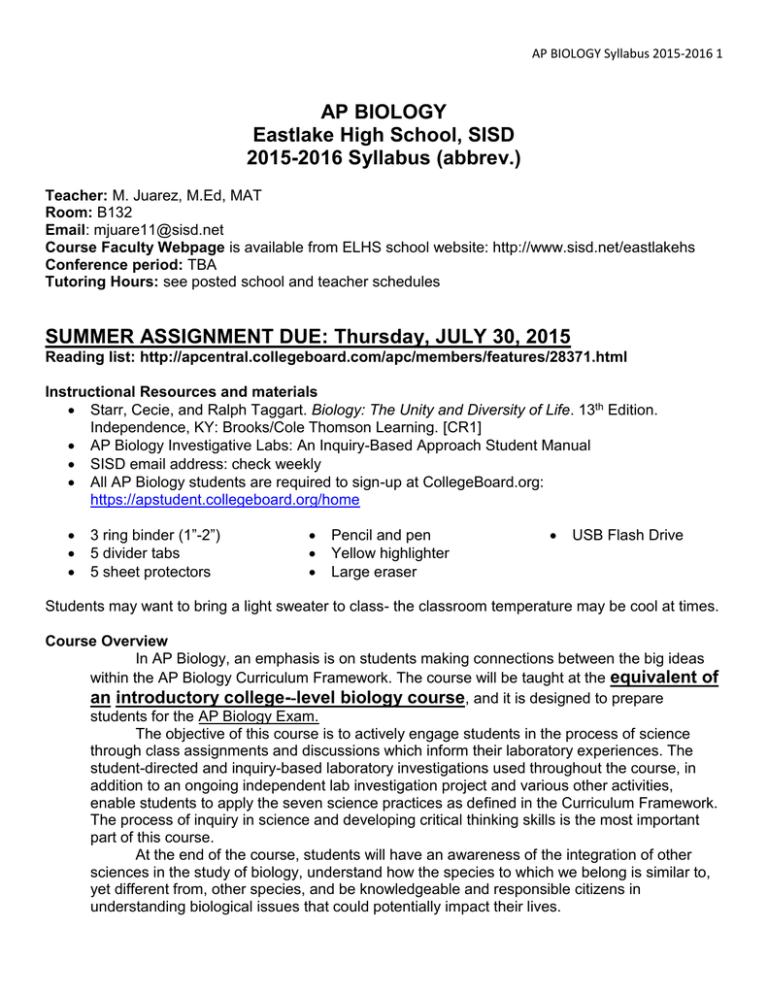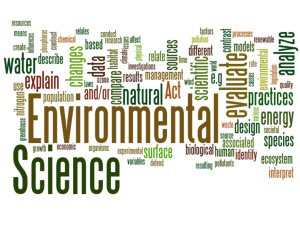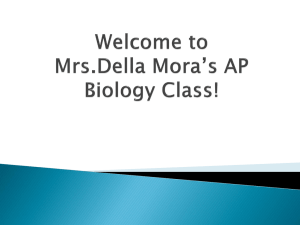AP BIO Syllabus - Socorro Independent School District
advertisement

AP BIOLOGY Syllabus 2015-2016 1 AP BIOLOGY Eastlake High School, SISD 2015-2016 Syllabus (abbrev.) Teacher: M. Juarez, M.Ed, MAT Room: B132 Email: mjuare11@sisd.net Course Faculty Webpage is available from ELHS school website: http://www.sisd.net/eastlakehs Conference period: TBA Tutoring Hours: see posted school and teacher schedules SUMMER ASSIGNMENT DUE: Thursday, JULY 30, 2015 Reading list: http://apcentral.collegeboard.com/apc/members/features/28371.html Instructional Resources and materials Starr, Cecie, and Ralph Taggart. Biology: The Unity and Diversity of Life. 13th Edition. Independence, KY: Brooks/Cole Thomson Learning. [CR1] AP Biology Investigative Labs: An Inquiry-Based Approach Student Manual SISD email address: check weekly All AP Biology students are required to sign-up at CollegeBoard.org: https://apstudent.collegeboard.org/home 3 ring binder (1”-2”) 5 divider tabs 5 sheet protectors Pencil and pen Yellow highlighter Large eraser USB Flash Drive Students may want to bring a light sweater to class- the classroom temperature may be cool at times. Course Overview In AP Biology, an emphasis is on students making connections between the big ideas within the AP Biology Curriculum Framework. The course will be taught at the equivalent of an introductory college-‐level biology course, and it is designed to prepare students for the AP Biology Exam. The objective of this course is to actively engage students in the process of science through class assignments and discussions which inform their laboratory experiences. The student-directed and inquiry-based laboratory investigations used throughout the course, in addition to an ongoing independent lab investigation project and various other activities, enable students to apply the seven science practices as defined in the Curriculum Framework. The process of inquiry in science and developing critical thinking skills is the most important part of this course. At the end of the course, students will have an awareness of the integration of other sciences in the study of biology, understand how the species to which we belong is similar to, yet different from, other species, and be knowledgeable and responsible citizens in understanding biological issues that could potentially impact their lives. AP BIOLOGY Syllabus 2015-2016 2 AP® Biology Big Ideas The course is structured around the enduring understandings within the big ideas as described in the AP® Biology Curriculum Framework. [CR2] Big Idea 1: The process of evolution drives the diversity and unity of life. Big Idea 2: Biological systems utilize free energy and molecular building blocks to grow, to reproduce, and to maintain dynamic homeostasis. Big Idea 3: Living systems store, retrieve, transmit, and respond to information essential to life processes. Big Idea 4: Biological systems interact, and these systems and their interactions possess complex properties. Students connect the enduring understandings within: Big Idea 1 (the process of evolution drives the diversity and unity of life) to at least one other big idea.[CR3a] Big Idea 2 (biological systems utilize free energy and molecular building blocks to grow, to reproduce, and to maintain dynamic homeostasis) to at least one other big idea. [CR3b] Big Idea 3 (living systems store, retrieve, transmit, and respond to information essential to life processes) to at least one other big idea. [CR3c] Big Idea 4 (biological systems interact and these systems and their interactions possess complex properties) to at least one other big idea. [CR3d] The course provides students with opportunities outside of the laboratory investigations to meet the learning objectives within Big Idea 1, Big Idea 2, Big Idea 3, and Big Idea 4. [CB4a,b,c,d] The course provides students with opportunities to connect their biological and scientific knowledge to major social issues (e.g., concerns, technological advances, innovations) to help them become scientifically literate citizens. [CR5] The student-directed laboratory investigations used throughout the course allow students to apply the seven science practices defined in the AP Biology Curriculum Framework and include at least two lab experiences in each of the four big ideas. [CR6] Students are provided the opportunity to engage in investigative laboratory work integrated throughout the course for a minimum of 25 percent of instructional time. Labs emphasize development and testing of the hypothesis, collection, analysis and presentation of data, as well as discussion of results to discover unanswered questions about the particular topics addressed. [CR7] The course provides opportunities for students to develop and record evidence of their verbal, written and graphic communication skills through laboratory reports, summaries of literature or scientific investigations, and oral, written, or graphic presentations. Students are required to report on all laboratory investigations. [CR8] AP BIOLOGY Syllabus 2015-2016 3 Graded work: Daily grades (50%): assignments, readings, quizzes, lab reports, journal article analyses, month-in-science logs, book reviews, project updates, etc Test grades (30%): content tests, projects, progress on independent investigation*, presentations, etc Final exam (20%): cumulative exams based on content and lab investigations Readings: Include book/textbook/ journal articles. Students are provided with guided reading questions and are required to take notes. Activities/ Labs/ Investigations: Some activities are expected to be performed outside of class time & students are expected to hand in lab reports for evidence of completion. Assessment: A variety of assessments are used throughout the course, including but not limited to quizzes, exams, portfolios, presentations, reports, etc Independent Investigation/ Science Fair Project*: Original research-based investigation that will cumulate at the end of May 2016. Explicit instructions will be provided at the end of the first week of the 2015-2016 school year. Make-up work/ Tests: must be completed with two days after return from absence Late work: 1 week with penalty (extra work or points off) Extra credit is at my discretion and may not be offered. Classroom rules: Falcons SOAR 1. Show respect: respect yourself, others, and property; do not disrupt class during instruction/ lab 2. Obey rules: no food, drink, or electronic use in class; follow school dress code and code of conduct; raise hand if have questions or concerns 3. Act safely: follow all written and verbal instructions, especially during lab; no horseplay 4. React Responsibly: use the appropriate vocabulary, tone, and volume of voice in class and on campus; aggressive or violent behavior will not be tolerated; this is a no bully school 5. Be ready with your materials each day to complete assigned tasks and learn. Must wear ID on lanyard around neck 6. Arrive on time, follow all directions/ instructions, participate, and stay on task Please note that you must also follow all campus rules, not limited to but including dress code. For more information, please see District Student Code of Conduct. For success in AP courses: read and take notes in advance. For example: read the chapter and take Cornell notes before the lecture and associated labs and activities. AP BIOLOGY Syllabus 2015-2016 4 Procedures: 1. Entering and leaving the class a. Enter room, sit in assigned seat, and have materials ready prior to tardy bell b. Read all instructions on white board c. Complete bell-ringers, including quizzes, as assigned within first few minutes of class d. Before leaving classroom, place all class materials, desks, etc as they were when you arrived 2. Restroom: you must have your ID visibly on you a. restroom use is prohibited the first and last 10 minutes of class except for emergencies or medically related situations; b. abuse of restroom privileges may result in lunch detention and/ or suspension of privileges 3. Conferences a. If you or your parents would like to schedule a conference (before or after school or during my conference period), please call or email to make arrangements. b. If you have any circumstances or situations come up that prevent you from being successful in my classroom, please come talk to me privately. Your health, safety, and success matter : do not wait until it is too late. 4. All students will be required to sign up for this course on Schoology by week 4. (instructions will be given week 2) Discipline Policy: Rewards: Staying on task and mastering concepts will result in a reward. Examples include, but are not limited to: Verbal praise Written praise Call to parents Consequences: Being off task or violating a class/school/district rule or policy will result in a consequence. Redirection Verbal warning Written warning Detention (student- teacher conference) Parent call and detention Referral Severe disruptions, Aggression/ violence, or threats of, will be immediately referred to the office; repeated violations may result in a citation and/or removal from the course. Tutoring hours: most mornings, B lunch, after school. See posted tutoring schedule in hallways for more specific information; mandatory tutoring appointments be assigned in the case of excessive absences and/or failing grades. AP BIOLOGY Syllabus 2015-2016 5 Science Practices for AP Biology A practice is a way to coordinate knowledge and skills in order to accomplish a goal or task. The science practices enable students to establish lines of evidence and use them to develop and refine testable explanations and predictions of natural phenomena. These science practices capture important aspects of the work that scientists engage in, at the level of competence expected of AP Biology students. Science Practice 1: The student can use representations and models to communicate scientific phenomena and solve scientific problems. 1.1 The student can create representations and models of natural or man-made phenomena and systems in the domain. 1.2 The student can describe representations and models of natural or manmade phenomena and systems in the domain. 1.3 The student can refine representations and models of natural or man-made phenomena and systems in the domain. 1.4 The student can use representations and models to analyze situations or solve problems qualitatively and quantitatively. 1.5 The student can reexpress key elements of natural phenomena across multiple representations in the domain. Science Practice 2: The student can use mathematics appropriately. 2.1 The student can justify the selection of a mathematical routine to solve problems. 2.2 The student can apply mathematical routines to quantities that describe natural phenomena. 2.3 The student can estimate numerically quantities that describe natural phenomena. Science Practice 3: The student can engage in scientific questioning to extend thinking or to guide investigations within the context of the AP course. 3.1 The student can pose scientific questions. 3.2 The student can refine scientific questions. 3.3 The student can evaluate scientific questions. Science Practice 4: The student can plan and implement data collection strategies appropriate to a particular scientific question. 4.1 The student can justify the selection of the kind of data needed to answer a particular scientific question. 4.2 The student can design a plan for collecting data to answer a particular scientific question. 4.3 The student can collect data to answer a particular scientific question. 4.4 The student can evaluate sources of data to answer a particular scientific question. Science Practice 5: The student can perform data analysis and evaluation of evidence. 5.1 The student can analyze data to identify patterns or relationships. 5.2 The student can refine observations and measurements based on data analysis. 5.3 The student can evaluate the evidence provided by data sets in relation to a particular scientific question. Science Practice 6: The student can work with scientific explanations and theories. 6.1 The student can justify claims with evidence. 6.2 The student can construct explanations of phenomena based on evidence produced through scientific practices. 6.3 The student can articulate the reasons that scientific explanations and theories are refined or replaced. 6.4 The student can make claims and predictions about natural phenomena based on scientific theories and models. 6.5 The student can evaluate alternative scientific explanations. Science Practice 7: The student is able to connect and relate knowledge across various scales, concepts, and representations in and across domains. 7.1 The student can connect phenomena and models across spatial and temporal scales. 7.2 The student can connect concepts in and across domain(s) to generalize or extrapolate in and/or across enduring understandings and/or big ideas. AP BIOLOGY Syllabus 2015-2016 6 Laboratory Investigations: This is a list of major lab/inquiry investigations that will be performed in class. Students will also be responsible for an ongoing independent research investigation project. Additional labs and investigations may be incorporated as deemed necessary. Big Idea 1: Evolution Lab 1: Artificial Selection [CR 4a] Lab 2: Mathematical Modeling: Hardy-Weinberg [CR 4a] Lab 3: Comparing DNA Sequences to Understand Evolutionary Relationships with BLAST [CR 4a] Big Idea 2: Cellular Processes: Energy and Communication Lab 4: Diffusion and Osmosis [CR 4b] Lab 5: Photosynthesis [CR 4b] Lab 6: Cellular Respiration [CR 4b] Big Idea 3: Genetics and Information Transfer Lab 7: Cell Division: Mitosis and Meiosis [CR 4c] Lab 8: Biotechnology: Bacterial Transformation[CR 4c] Lab 9: Biotechnology: Restriction Enzyme Analysis of DNA [CR 4c] Big Idea 4: Interactions Lab 10: Energy Dynamics [CR 4d] Lab 11: Transpiration [CR 4d] Lab 12: Fruit Fly Behavior [CR 4d] Lab 13: Enzyme Activity [CR 4b] Enduring Understandings 1.A: Change in the genetic makeup of a population over time is evolution. 1.B: Organisms are linked by lines of descent from common ancestry. 1.C: Life continues to evolve within a changing environment. 1.D: The origin of living systems is explained by natural processes. 2.A: Growth, reproduction and maintenance of the organization of living systems require free energy and matter. 2.B: Growth, reproduction and dynamic homeostasis require that cells create and maintain internal environments that are different from their external environments. 2.C: Organisms use feedback mechanisms to regulate growth and reproduction, and to maintain dynamic homeostasis. 2.D: Growth and dynamic homeostasis of a biological system are influenced by changes in the system’s environment. 2.E: Many biological processes involved in growth, reproduction and dynamic homeostasis include temporal regulation and coordination. 3.A: Heritable information provides for continuity of life. 3.B: Expression of genetic information involves cellular and molecular mechanisms. 3.C: The processing of genetic information is imperfect and is a source of genetic variation. 3.D: Cells communicate by generating, transmitting and receiving chemical signals. 3.E: Transmission of information results in changes within and between biological systems. 4.A: Interactions within biological systems lead to complex properties. 4.B: Competition and cooperation are important aspects of biological systems. 4.C: Naturally occurring diversity among and between components within biological systems affects interactions with the environment. AP BIOLOGY Syllabus 2015-2016 7 Cheating: Cheating consists of submitting someone else’s work under your name, obtaining information from someone other than the instructor during an exam, making copies of disks, files, or other data sources (either program or work/files), etc. Consequences may include, but are not limited to, the following: receiving zeros for scores, extra assignments, detention/ SAC, parent-teacher conferences, administrative intervention, removal from activities, loss of privileges, etc. Electronics: 1. Cell phones & any electronic devices will be turned off during lecture & lab sessions. 2. Cell phones are strictly prohibited during exam sessions and during lab. 3. Electronic devices may be used when explicitly allowed by the teacher as part of instructional activities. AP Exam: The exam is given in May of each year Section 1: (90 minutes, 50%) Multiple Choice (63), Grid-in responses (6) Section 2: (90 minutes, 50%) Free Response questions (2 long, 6 short) All AP Biology students are required to sign-up at CollegeBoard.org: https://apstudent.collegeboard.org/home Learn more about AP Biology and what it can do for Students: https://apstudent.collegeboard.org/apcourse/ap-biology Description of exam, including sample questions: https://secure-media.collegeboard.org/ap-student/course/ap-biology-2012-course-examdescription.pdf Information on AP Biology Exam Practice: https://apstudent.collegeboard.org/apcourse/ap-biology/exam-practice Mock Tests will be given at the start of the Fall and Spring semesters. These will NOT be full tests. They will include sample questions and must be completed in 30 minutes. AP BIOLOGY Syllabus 2015-2016 8 Please review this syllabus with your parents and sign below. This syllabus must be kept in your binder at all times. If you lose it, you are still responsible for the information contained here-in. I have read the syllabus and understand the fundamental information needed to be successful in this course. I understand that cheating in any form is not tolerated in AP courses. Student Name _________________________________ Student Signature ______________________________________________________ date______________ I have read the syllabus and understand the fundamental information needed for my student(s) to be successful in this course. I understand that cheating in any form is not tolerated in AP courses. Parent Name _________________________________ Parent Signature ______________________________________________________ date______________





